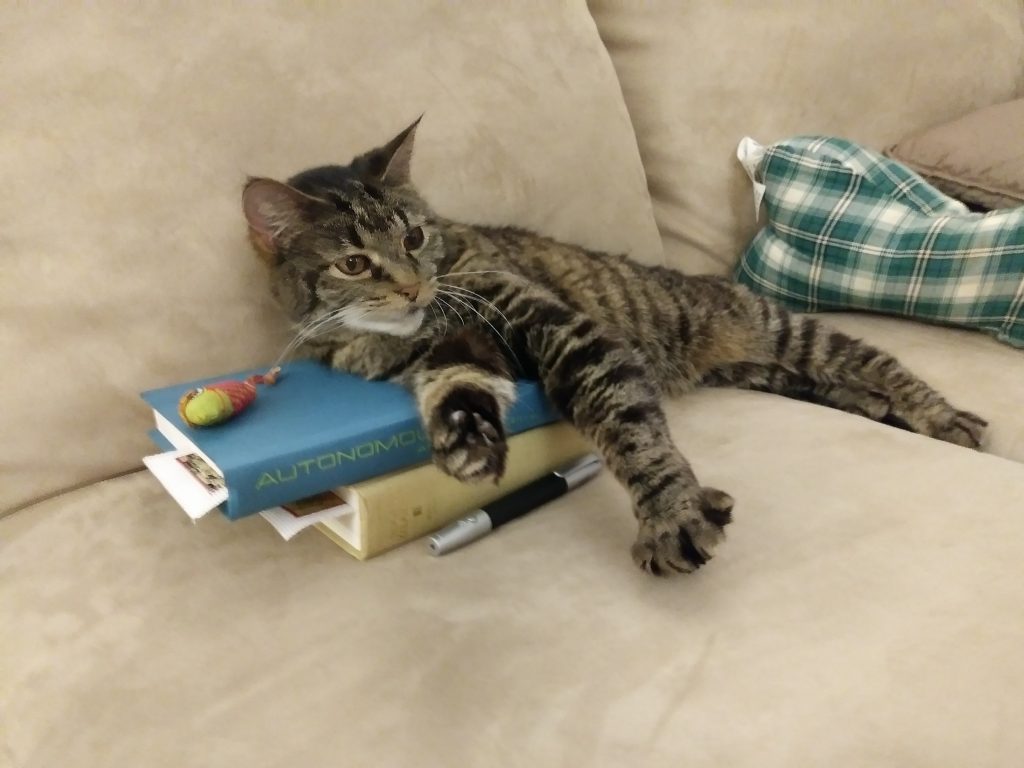(1) LOOKING FOR SHADOWS. Leah Schnelbach’s “Groundhog Day Breaks the Rules of Every Genre” is a masterpiece about one of my favorite movies. (It first appeared on Tor.com in 2014.)
Groundhog Day succeeds as a film because of the way it plays with, subverts, and outright mocks the tropes of each of the genres it flirts with. While some people would call it a time travel movie, or a movie about small town America, or the most spiritual film of all time, or a rom-com, it is by breaking the rules of each of those types of films that it ultimately transcends genre entirely.
(2) SHARKNADO 5. Not sure why Syfy and studio The Asylum picked Groundhog Day to announce there will be a fifth Sharknado movie, unless it’s to wink at the fact they’re doing the same thing over and over again:
The original 2013 “Sharknado” introduced the concept of a shark-laden twister via one bearing down on Los Angeles. In “Sharknado 2: The Second One,” New York City was the target of the disaster, and in “Sharknado 3: Oh Hell No!” a mega-sharknado made its way down the East Coast from Washington, D.C. to Florida. In the most recent installment, the very-close-to-copyright-infringement-titled “Sharknado: The 4th Awakens,” the shark-infested storms went national. The film ended with the Eiffel Tower ripping away from Paris and crashing down on Niagara Falls, setting the stage for the fifth edition of America’s answer to the sprawling sagas of the ancient world.
In “Sharknado 5,” with much of North America lying in ruins, the rest of the world braces for a global sharknado. Fin Shepard (Ziering) and his family must put a stop to this disaster before Earth is obliterated.
(3) TODAY’S SCROLL TITLE. On the other hand, Daniel Dern hopes you will add iterations of your own to his faux children’s book for Filers.
If You Give A Kzin A Kazoo…
whose text perhaps goes…
… he’ll <blatt> and leap.
If a Kzin <blatt>s and leaps,
he’ll rip you from gehenna to duodenum. [1]
If a Kzin rips you from gehenna to duodenum,
well, that’s the end of the story as far as you’re concerned,
unless you’ve got either an autodoc [2] nearby, or have Wolverine-class mutant healing factor.
[1] per Don Marquis, Archie & Mehitabel — Mehitabel on Marriage, IIRC.
[2] and health care insurance that will cover you 🙁
Probably if you put all that in, Filers will contribute a few dozen more verses.
(4) BOMBS AWAY. Before telling the “Five Things I Learned Writing Exo”, Fonda Lee confesses that Exo began life as a failed NanNoWriMo novel. (A guest post at Terrible Minds.)
This is how it went: I wrote 35,000 words by November 20th or so, and stalled out. It wasn’t working. At all. I read the manuscript from the beginning and hated all of it with the nauseous loathing that writers feel when looking at their own disgusting word messes. I had a shiny story idea in my head but it was emerging as dog vomit. So I quit. I failed NaNoWriMo hard.
I trashed everything I’d written and started again. I wrote a new draft over several months, and then rewrote 50% of that one. And did it again. After the book sold, I did another major revision with my editor. I was relieved and excited by how it was getter better and better, but part of me was also surprised and disheartened. I mean, Zeroboxer was picking up accolades and awards, and whoa, I got to go to the Nebula Awards as a finalist and dance on stage, so why the hell was it so hard to write another book?! This whole writing thing ought to be easier now, right?
Wrong. In talking (griping, whining, crying) to wiser authors, I learned there was wide agreement that the second book is often a complete bitch to write. A very loud voice in your head is telling you that because you’re now a Published Author, you should be writing better and faster, plus doing author promotion stuff with an effortless grin.
(5) REMEMBERING PAN. J. M. Barrie was one of several authors who put science-related observation into fantasies. The BBC tells you about it: “What Peter Pan teaches us about memory and consciousness”.
In this way, the stories appear to follow a tradition of great cross-pollination between the arts and the sciences – particularly in children’s literature. Charles Kingsley’s The Water-Babies was written, in part, as a response to Darwin’s theory of evolution, while Alice’s Adventures in Wonderland were a playful exploration of mathematics and logic. Even some of Hans Christian Andersen’s tales were inspired by new scientific and technological developments – such as the invention of the home microscope.
(6) A LARGER-THAN-EXPECTED COLLISION. The Large Hadron Collider didn’t end the world, as some cranks feared, but it did end this creature: “World’s Most Destructive Stone Marten Goes On Display In The Netherlands”
On Nov. 20, 2016, the animal hopped over a fence at the $7 billion Large Hadron Collider in Switzerland, touched a transformer and was electrocuted by 18,000 volts.
The marten died instantly. The collider, which accelerates particles to near the speed of light to study the fiery origins of the universe, lost power and shut down.
“There must have been a big flame,” said Kees Moeliker, the director of the Natural History Museum in Rotterdam and the man behind its Dead Animal Tales exhibit, where the preserved marten is now displayed.
“It was scorched. When you’re not really careful with candles and your hair, like that,” he explained. “Every hair of this creature was kind of burned and the whiskers, they were burned to the bare minimum and especially the feet, the legs, they were cooked. They were darker, like roasted.”
“It really had a bad, bad encounter with this electricity.”
Chip Hitchcock adds, “Marten furs were once sufficiently tradable that Croatia’s currency, the kuna, takes its name from the Croatian word for the beast.“
(7) YOUNG PEOPLE READ OLD SFF. James Davis Nicoll turns the panel loose on Roger Zelazny’s “A Rose for Ecclesiastes”.
I selected 1963’s A Rose for Ecclesiastes for a few reasons. The least important is because I only recently read it myself (the story kept coming up in the context of a grand review project of mine and I got tired of admitting over and over again that I had not read it.). Another is its historical significance: this is one of the last SF stories written before space probes showed us what Mars was really like. The final reason is this story was nominated for a Hugo and I am hopeful that the virtues the readers saw a half century ago are still there.
Let’s find out!
(8) THE FOUNDER. Selected writings by Hugo Gernsback have been compiled in The Perversity of Things: Hugo Gernsback on Media, Tinkering, and Scientifiction, edited by Grant Wythoff. The book was published in November by the University of Minnesota Press.
In 1905, a young Jewish immigrant from Luxembourg founded an electrical supply shop in New York. This inventor, writer, and publisher Hugo Gernsback would later become famous for launching the first science fiction magazine, Amazing Stories, in 1926. But while science fiction’s annual Hugo Awards were named in his honor, there has been surprisingly little understanding of how the genre began among a community of tinkerers all drawn to Gernsback’s vision of comprehending the future of media through making. In The Perversity of Things, Grant Wythoff makes available texts by Hugo Gernsback that were foundational both for science fiction and the emergence of media studies.
…The Perversity of Things aims to reverse the widespread misunderstanding of Gernsback within the history of science fiction criticism. Through painstaking research and extensive annotations and commentary, Wythoff reintroduces us to Gernsback and the origins of science fiction.
Bruce Sterling gives the book a powerful endorsement:
Grant Wythoff’s splendid work of scholarship dispels the dank, historic mists of a literary subculture with starkly factual archival research. An amazing vista of electronic media struggle is revealed here, every bit as colorful and cranky as Hugo Gernsback’s pulp magazines—even the illustrations and footnotes are fascinating. I’m truly grateful for this work and will never think of American science fiction in the same way again.
(9) SARAH PRINCE. The family obituary for Sarah Prince, who died last month, appeared in the Plattsburgh (NY) Press-Republican.
Sarah Symonds Prince (born July 11, 1954) died unexpectedly of congestive heart failure in late January in her Keene Valley home. A long time resident and well-loved community member, she was active in the Keene Valley Congregational Church choir and hand bell choir, the town community garden program; she was a former member of the Keene Valley Volunteer Fire Department.
Sarah was an avid photographer and a ceramic artist, and a freelance graphic designer. She was an influential member of the science fiction fan community and publisher (in the 1980s/90s) of her own fanzine. Sarah enjoyed going to interesting places whether around the corner or halfway around the world. She loved the many dogs and cats that were constant companions in her life.
Born in Salem, Mass., Sarah was the third child of David Chandler Prince Jr. and Augusta Alger Prince. She grew up in Cincinnati, Ohio, where she graduated from Walnut Hills High School. Sarah’s love of Keene Valley, N.Y., follows family ties that date back four generations as regular summer visitors.
Sarah graduated from the Ohio State University with a BFA degree. She trained in print layout and typesetting and worked in typesetting, layout and graphic arts for several publications, including Adirondack Life from 1990-93, a job which brought her to live full-time in Keene Valley. A deep curiosity about technology and a sustainable world led Sarah to Clinton Community College to study computer technology and earn an Environmental Science AA degree in May 2016.
Sarah lived with disability from mental illness and substance abuse for many years. She worked to raise awareness and understanding of the challenges faced by herself and others. She positively touched many who were also struggling.
Sarah is survived by her mother, Augusta Prince of Hanover, N.H.; four siblings, Timothy Prince, Catharine Roth, Charlotte Hitchcock, and Virginia Prince; seven nieces and nephews; and six grand nieces and nephews.
Donations in her memory can be made to North Country SPCA or the Keene Valley Library. Arrangements have been entrusted to Heald Funeral Home, 7521 Court Street, Plattsburgh, N.Y. To light a memorial candle or leave an online condolence please visit http://www.healdfuneralhomeinc.com
(10) TODAY IN HISTORY
- February 2, 1882 – James Joyce is born .
And that reminds John King Tarpinian of a story:
Sylvia Beach, owner of the bookstore Shakespeare and Co. in Paris, published the novel herself in 1922, but it was banned in the United Kingdom and in the United States until 1933. Every July Ray Bradbury and his family would vacation in France. Ray would always visit Shakespeare and Company. The bookshop would make sure they had a book that Ray wanted, such as first editions of Jules Verne.
(11) CREEPTASTIC. Dread Central reports “Zak Bagan’s Haunted Museum to feature ‘one of the most dangerous paranormal possessions in the world’” — Peggy the Doll.
Excited about visiting Zak Bagans’ Haunted Museum when it opens? Of course you are! This latest story though… this latest addition to Zak’s house of madness? Well, it’s going to be up to you whether or not you take your chances and take a look.
Zak has just informed us exclusively that he’s now in possession of the infamous “Peggy the Doll,” which he obtained from its previous owner, Jayne Harris from England. Featured on an episode of his series “Deadly Possessions,” Peggy is not for the faint of heart. It’s said you can be affected by Peggy by just looking at her… in person or in photos. As a result “Deadly Possessions” aired the episode with a disclaimer for viewers: a first for both the show and the paranormal in general.
(12) BUNK. Jason Sanford muses about “An alternate history of alternative histories”:
Ironically, the last book my grandfather read was edited by Poul Anderson, one of our genre’s early authors of alternate histories. Anderson’s Time Patrol stories, where valiant time travelers ensure history stays on its “correct” timeline, are an integral and fun part of SF’s long tradition of time travel fiction focused on keeping history pure. He also wrote a famous series of alternate history fantasies called Operation Chaos, originally published by The Magazine of Fantasy and Science Fiction in the 1950s. In these stories World War II was fought between completely different countries with magical creatures such as werewolves and witches.
Of course, Anderson’s stories of time travelers keeping the timeline pure and correct seem a little simplistic today, just as historical narratives today are far more complex than they were decades ago. I think this is partly because most historians now recognize how imprecisely history is recorded. History as it is written can even be called the original version of the alternate history genre, where the story we’re told deviates from what really happened.
After all, history is written by the victors, as the cliche states. Which means much of what happened in the past is left out or altered before history is recorded. And even the victors don’t name all the victors and don’t celebrate all their victories and deeds.
Theodore Sturgeon famously said that “ninety percent of everything is crap.” This applies equally to history as we know it — including the history of the alternate history genre.
(13) WHITE FLIGHT. Andrew Russell and Lee Vinsel, in “Whitey on Mars”, ask if Elon Musk’s Martian proposals are part of a dream by rich and powerful people to further isolate themselves from the masses. (The title references Gil Scott-Heron’s 1970 “Whitey on the Moon.”)
Musk insists that humans in fact ‘need’ to go to Mars. The Mars mission, he argues, is the best way for humanity to become what he calls a ‘space-faring civilisation and a multi-planetary species’. This otherworldly venture, he says, is necessary to mitigate the ‘existential threat’ from artificial intelligence (AI) that might wipe out human life on Earth. Musk’s existential concerns, and his look to other worlds for solutions, are not unique among the elite of the technology world. Others have expressed what might best be understood as a quasi-philosophical paranoia that our Universe is really just a simulation inside a giant computer.
Musk himself has fallen under the sway of the Oxford philosopher Nick Bostrom, who put forward the simulation theory in 2003. Bostrom has also argued that addressing ‘existential risks’ such as AI should be a global priority. The idea that Google’s CEO Larry Page might create artificially intelligent robots that will destroy humanity reportedly keeps Musk up at night. ‘I’m really worried about this,’ Musk told his biographer. ‘He could produce something evil by accident.’
These subjects could provide some teachable moments in certain kinds of philosophy classes. They are, obviously, compelling plot devices for Hollywood movies. They do not, however, bear any relationship to the kinds of existential risks that humans face now, or have ever faced, at least so far in history. But Musk has no connection to ordinary people and ordinary lives. For his 30th birthday, Musk rented an English castle, where he and 20 guests played hide-and-seek until 6am the following day. Compare this situation with the stories recounted in Matthew Desmond’s book Evicted (2016), where an entire housing industry has arisen in the US to profit from the poverty of some families, who often move from home to home with little hope of ever catching up, let alone getting ahead.
(14) COMIC SECTION. Martin Morse Wooster says, “I think today’s Prickly City expresses the dreams of many Filers.”
(15) ANOTHER COUNTRY HEARD FROM. When the next Doctor Who is chosen, one party thinks someone besides a human deserves consideration: “New Doctor Who should be a Dalek, say Daleks”, at The Daily Mash.
The Skaro natives have petitioned the BBC for ‘better representation’ from a show which has historically ‘erased and demonised’ their proud race.
The Supreme Dalek said: “It’s not the 1960s anymore. These narratives about heroic Gallifreyans saving humanoids from extermination are outdated and offensive.
“My son is an eight-year-old New Paradigm Dalek and his eyestalk droops whenever he turns on his favourite show to see that yet again, the Daleks are the baddies.…
(16) WHEN ROBOTS LAY DOWN ON THE JOB. Fynbospress told Mad Genius Club readers about running into a wall while using Word:
Interesting quirk I learned recently on MS Word. Say you have a MilSF novel, and you haven’t added the last names, planets, etc. to the customized dictionary (So they all show as a spelling error). As you’re reading through, it pops up a window saying “there are too many spelling errors in this document to show.” And promptly cuts out the red spelling and blue grammar lines.
(17) INFERNO. JJ says, quite rightly, this photo of the West Kamokuna Skylight in Hawaii resembles sculpture of bodies being sucked into hell.
If lava has the right viscosity, it can travel across a landscape via channels. The lava either forms the channels itself or uses a preexisting one. Along the same vein, lava tubes are essentially channels that reside underground and also allow lava to move quickly. Tubes form one of two ways. A lava channel can form an arc above it that chills and crystallizes, or an insulated pahoehoe flow can have lava still running through it while outer layers freeze. Lava tubes, by their nature, are buried. However, skylights form when the lava tube collapses in a specific area and allow one to see the flow inside the tube. Tubes can collapse completely and become channels, drain out, or get blocked up.
(18) FROM BC TO DC. CinemaBlend thinks the critical success of the DC Extended Universe hinges on the forthcoming Wonder Woman movie.
While Batman v Superman: Dawn Of Justice struggled to please critics, most agreed that Gal Gadot’s performance as Wonder Woman was one of its few shining lights. It’s hoped that the opportunity to explore the character even more, as well as take a peak at her origin story, will help to propel the DC Extended Universe forward, especially considering all of its recent troubles regarding both its releases and the films it has in development.
(19) I’M OUT. It may look like a chocolate chip thumbscrew, but it’s Dunking Buddy!

What if there was an easier, cleaner, more enjoyable way to enjoy dunking cookies in milk. Well the world is finally in luck, and based on the response so far, it couldn’t have come sooner! Two cookie dunking lovers, like so many others out there, took it upon themselves and created a cookie dunking device that does just that!
[Thanks to John King Tarpinian, Martin Morse Wooster, Andrew Porter, Chip Hitchcock, Moshe Feder, and JJ for some of these stories. Title credit goes to File 770 contributing editor of the day Daniel Dern.]










